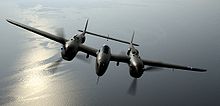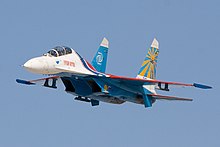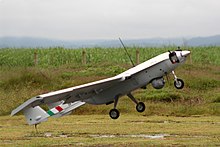




Some varieties of aircraft, such as flying wing aircraft, may lack a discernible fuselage structure and horizontal or vertical stabilizers, however the structure of a fixed-winged aircraft usually consists of the following major parts:
- A long narrow, cylindrical, spherical, odd shaped, form, called a fuselage, usually with tapered or rounded ends to make its shape aerodynamically smooth. The fuselage carries the human flight crew if the aircraft is piloted, the passengers if the aircraft is a passenger aircraft, other cargo or payload, and engines and/or fuel if the aircraft is so equipped. The pilots operate the aircraft from a cockpit located at the front or top of the fuselage and equipped with windows, controls, and instruments. Passengers and cargo occupy the remaining available space in the fuselage. Some aircraft may have two fuselages, or additional pods or booms.
- A wing (or wings in a multiplane) with an airfoil cross-section shape, used to generate aerodynamic lifting force to support the aircraft in flight by deflecting air downward as the aircraft moves forward. The wing halves are typically symmetrical about the plane of symmetry (for symmetrical aircraft). The wing also stabilizes the aircraft about its roll axis and the ailerons control rotation about that axis.
- At least one control surface (or surfaces) mounted vertically usually above the rear of the fuselage, called a vertical stabilizer. The vertical stabilizer is used to stabilize the aircraft about its yaw axis (the axis in which the aircraft turns from side to side) and to control its rotation along that axis. Some aircraft have multiple vertical stabilizers.
- At least one horizontal surface at the front or back of the fuselage used to stabilize the aircraft about its pitch axis (the axis around which the aircraft tilts upward or downward). The horizontal stabilizer (also known as tailplane) is usually mounted near the rear of the fuselage, or at the top of the vertical stabilizer, or sometimes a canard is mounted near the front of the fuselage for the same purpose.
- On powered aircraft, one or more aircraft engines are propulsion units that provide thrust to push the aircraft forward through the air. The engine is optional in the case of gliders that are not motor gliders. The most common propulsion units are propellers, powered by reciprocating or turbine engines, jet engines or even rocket motors, which provide thrust directly from the engine and usually also from a large fan mounted within the engine. When the number of engines is even, they are distributed symmetrically about the roll axis of the aircraft, which lies along the plane of symmetry (for symmetrical aircraft); when the number is odd, the odd engine is usually mounted along the centerline of the fuselage.
- Landing gear, a set of wheels, skids, or floats that support the aircraft while it is on the surface.



0 comments:
Post a Comment